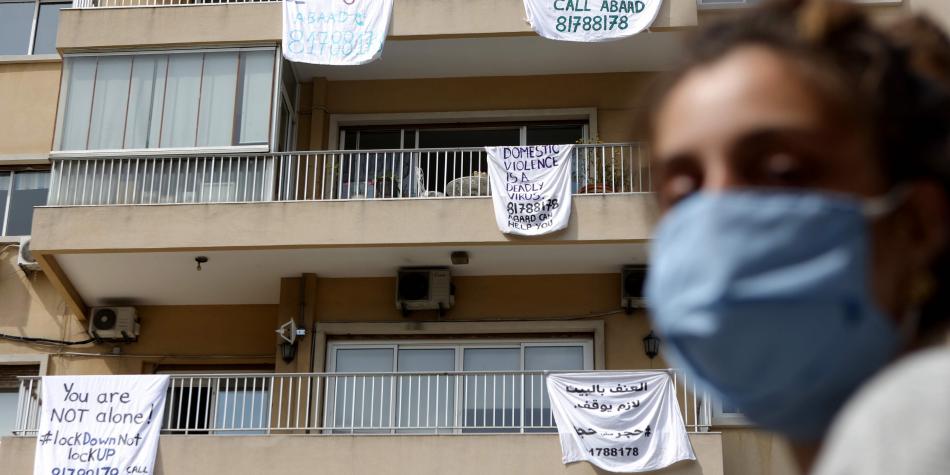Image courtesy of El Tiempo. Photographer Patrick Baz for AFP.
As women battle to survive COVID19 they face a second pandemic: increasing gender-based violence. Are States’ responses enough?
Simone de Beauvoir once said that only one crisis would suffice to question the acquired rights of women. The plurality of these rights include, among others, the right to live a life free of violence. The COVID19 pandemic has made evident the veracity of Beauvoir’s thought, as its impact on health and the economy has aggravated the risks women face in their everyday lives.
As UN Women has indicated, since the outbreak of the pandemic, a common analysis of gender violence begins by acknowledging that lockdown measures constitute a risk factor for women’s lives. This heartbreaking idea can be explained by two elements: (1) in situations of lockdown there is a decrease in the social support offered to women victims of gender violence; and (2) simultaneously, the social control over the aggressor decreases.

In the midst of the difficulties that lockdown measures generate, reports of gender violence have significantly increased throughout the world. In Italy, the number of complaints tripled during the period of confinement. In Spain, calls to 016 rose by 269% between March 14 — when the state of alarm was declared — and March 29. This same trend was witnessed in Germany, where Berlin’s chief of police, Barbara Slowik, denounced in April an exacerbated increase in domestic violence. In Mexico, calls to report gender-based violence had an increase of 60%. Furthermore, Colombia has undergone a 103% increase of calls to its emergency line, with a notable 230% increase of calls to the Purple Line (Línea Púrpura) in Bogotá. Similarly, Peru has witnessed an increase of 43.2% more calls to its 100 emergency line throughout the pandemic, while in Argentina calls to 144 have increased by 39%.
European states have responded to the growing complaints of gender violence by enabling shelters for women through the immediate adoption of public policies. Portugal announced in April that it would enable two facilities to welcome around a hundred women, while in Spain many regional governments have set up new foster homes.
On the other side of the world the response is not very different. Latin American states have fallen short to their duty of protection by enabling emergency response lines. In El Salvador, confidential emergency services are being provided through a special Whatsapp line and social networks. For its part, Peru has established emergency phone and chat lines to receive claims, together with shelters and attention centers for women. In Mexico, shelters reached their maximum capacity and have no governmental budget to ensure their operation during the following months. Moreover, Colombia has recently announced the creation of an early prevention system for violence against women and has completely turned its public services to virtual mode to ensure accessibility.
Nonetheless, shelter and emergency lines measures are still not a sufficient response to address the increasing gender-based violence. In no case should a woman who suffers violence of any type be forced to resort to the option of leaving her home. As recommended by the CEDAW Committee in its Covid-19 guidelines, it is the aggressor who must leave the family home.
As the pandemic evolves, lockdown measures are not the only risk factor for gender violence. In many countries, women are also affected by a second risk factor: precariousness, the situation of economic dependency with the aggressor, which is usually linked to the predominant role of women as caregivers for families.
Even in the current crisis situation, women citizens who suffer violence are still seeking help through institutions and official complaint mechanisms. Perhaps it is a good time to rethink this dynamic. It may be necessary to enable alternative mechanisms that facilitate access to protection and allow for public institutions to reach the homes where violence exists. In addition, these mechanisms must be considered as essential services in the pandemic context.
For States, this change in dynamics implies a firm commitment to preventing gender violence: maintaining States’ budgets to alleviate gender violence; reducing economic dependency of women by fostering equality in the economic sector; ensuring training of State agents on gender perspective, among others. It is only through the implementation of affirmative gender-based public policies that States can ensure that the rights of women in times of crisis will not be lost.
Ivonne Garza is an associate at the O’Neill Institute for National and Global Health Law.
Cristina M. Zamora Gómez is a Ph.D. student in public international law at the University of Seville.



